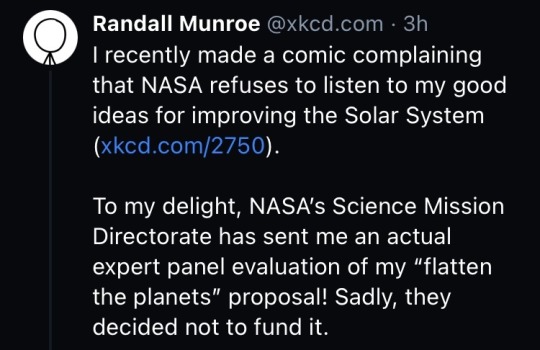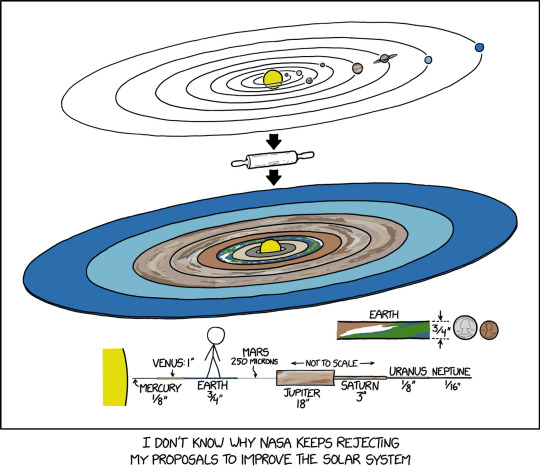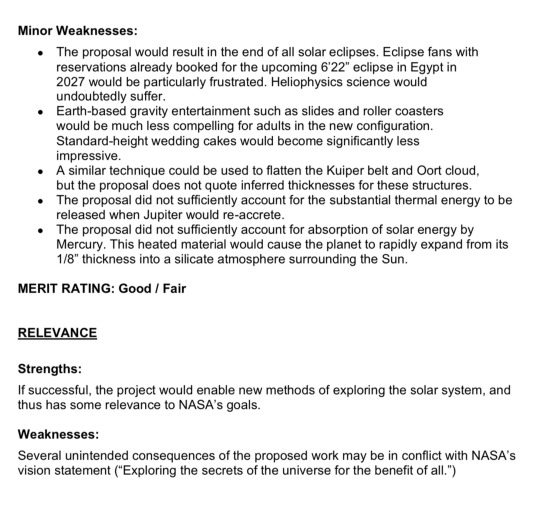#not in the process of flattening. the flattening happens magically. the consequences of the earth being a flat disk though
Explore tagged Tumblr posts
Text
[ID: Five images; in order, a tweet from Randall Munroe, a colored XKCD comic, and three screenshots of a NASA proposal evaluation.
The tweet reads: "I recently made a comic complaining that NASA refuses to listen to my good ideas for improving the Solar System (xkcd.com/2750). To my delight, NASA's Science Mission Directorate ahs sent me an actual expert pane evaluation of my "flatten the planets" proposal! Sadly, they decided not to fund it.
The colored XKCD comic shows three diagrams: one of a normal Solar System, with planets orbiting the Sun in a roughly flat plane, although relative distances are not accurate; an arrow points down from this model to a rolling pin, and another arrow points down from the rolling pin to the second model of the Solar System, in which all planets have been flattened into 'washers' that encircle the Sun where the planets originally orbited. The third diagram shows a horizontal viewpoint of the flattened planets: Mercury has been flattened to 1/8 of an inch, Venus to 1 inch, Earth to 3/4 of an inch, Mars to 250 microns, Jupiter to 18 inches, Saturn to 3 inches, Uranus to 1/8 of an inch, and Neptune to 1/16th of an inch. A notation above Jupiter and Saturn notes that the horizontal distances are not to scale. Between the second and third diagram is a mini diagram, comparing the flattened Earth disk to a quarter (whose diameter is almost 1 1/2 times more than the proposed thickness of the Earth) and a penny (whose diameter is approximately the thickness of the Earth). The caption to the comic reads "I don't know why NASA keeps rejecting my proposals to improve the Solar System."
The NASA proposal evaluation reads thusly:
NASA Panel Evaluation of Research Proposal XKCD-2750 Research Program: Unsolicited Proposal
PI: Munroe, Randall Proposal Number: XKCD-2750 Title: Flatten the Planets
All proposals are proprietary and should be handled by the reviewer in a confidential manner. Comments on this page may be transmitted anonymously to the proposer.
Brief Summary of Overall Evaluation:
The project would modify the Solar System by flattening the planets to homogeneous rings, thereby giving the Solar System the rough appearance of a large Saturn. Each ring would be centered on a planet's existing semi-major axis. Each ring would extend from the previous ring to roughly halfway to the next planet. The innermost 'Mercury ring' would terminate at approximately 0.03 AU. Asteroids would be converted into round bearings to enable the low-friction rotation of the presumably rigid rings.
The proposal states it is a follow up to XKCD-2258. The PI claims this precursor proposal was declined, although NASA does not have a record of that proposal's formal rejection.
Intrinsic Merit:
Major Strengths:
The proposed new Solar System architecture would provide an effective 'radial space elevator' which would greatly simplify NASA's exploration of the Solar System, including flybys, landers, and sample return missions. For motion within the plane, Hohmann transfer orbits would no longer be necessary. Anything with wheels could become a spacecraft as it could drive to the planets directly (albeit slowly: there wouldn't be much of a grip due to reduced surface gravity). Travel outside the plane would become unnecessary entirely, except for special purposes, such as space tourism, bungee jumping, or research.
Orbital resonances between the planets (cf. Neptune vs Pluto, or Mercury's rotation vs. orbit) would cease to exist, reducing the need for NASA's future investment in orbital dynamics research.
The effect of seasons would cease to exist on Earth and other planets, simplifying seasonal migration patterns for both animal species and humans.
If successful, implementation of the proposed architecture would demonstrate the first real-world use of apparently novel incredibly strong materials, paving the way to their future use. Traditional materials would be broken apart by differential keplerian shear (e.g. Laplace 1787, and undergraduate problems sets annually since then).
The improved Solar System would allow for increased ice skating, cross-country skiing, and keplerian ice-boat racing in the outer Solar System.
The proposal would result in increased visibility of the Solar System to our galactic neighbors, due to the highly unnatural shape of the resultant occultation light curve. Forget micro-lensing: if the Solar System wants to be detected, flying a 6-billion-km opaque frisbee through space is the way to do it.
Minor Strengths:
The mail-in French reviewer regards it as a strength that all ducks would become Pressed Duck. Peking Duck would be removed from menus.
3D visualization of the Solar System is historically one of the most difficult ideas in introductory astronomy classes. Generations of future students would benefit from the simplified 'flatland' approach taken by the proposed configuration, which would eliminate the need for spherical geometry calculations and Euler angles.
All asteroids and comets would be moved to the orbital plane. All future comet discoveries would then by definition be of interstellar comets, removing any ambiguity about their origins and allowing for a direct detection of all interstellar asteroids and/or spacecraft.
Because all asteroids would be moved to the plane, zodiacal dust would be reduced to zero, causing a darker night-time sky. This would be mitigated by the fact that the concept of 'night' would disappear entirely in the proposed model.
If Apophis's current orbit were to be maintained, then the new Solar System configuration would ensure that the 2029 encounter with Apophis would result in an actual impact onto the Earth, rather than the 'near miss' currently predicted by orbital dynamics.
Major Weaknesses:
NASA's orbital assets (JWST, Juno, SOHO, and dozens more) would require rapid transfer to a heliocentric orbit passing near Mars, which would be the only region of the inner Solar System passable in the new configuration.
At 250 microns thick, Mars would be liable to be pierced completely by interplanetary dust particles. It would not stand a chance against the rover wheels.
WHERE DID PLUTO GO?? Pluto was discussed in proposal XKCD-2258 but has been dropped from this follow-up proposal. NASA's most recent statement on this matter is summarized as "I believe Pluto is a planet" [Bridenstine 2019].
The timescale for the actual flattening of the planets was not sufficiently addressed. Given the size of rolling pins generally available, rolling out a single planet could require timescales much longer than the duration of the proposed effort.
The figure showed that the flattened planets would be homogeneous, but the proposal failed to address the impact of differing compressibility and/or density of the planets. Self-gravity would be unable to maintain Jupiter's 18" thickness except in small portions made of smaller material.
The required Environmental Impact Statement did not accompany the proposal, nor was it referenced in the NSPIRES cover page. The panel believes this may have been an intentional omission.
Minor Weaknesses:
The proposal would result in the end of all solar eclipses. Eclipse fans with reservations already booked for the upcoming 6'22" eclipse in Egypt in 2027 would be particularly frustrated. Heliophysics science would undoubtedly suffer.
Earth-based gravity entertainment such as slides and roller coasters would be much less compelling for adults in the new configuration. Standard-height wedding cakes would become significantly less impressive.
A similar technique could be used to flatten the Kuiper Belt and Oort Cloud, but the proposal does not quote inferred thicknesses for these structures.
The proposal did not sufficiently account for the substantial thermal energy to be released when Jupiter would re-accrete.
The proposal did not sufficiently account for absorption of solar energy by Mercury. This heated material would cause the planet to rapidly expand from its 1/8" thickness into a silicate atmosphere surrounding the Sun.
Merit Rating: Good / Fair
Relevance:
Strengths:
If successful, the project would enable new methods of exploring the Solar System, and thus has some relevance to NASA's goals.
Weaknesses:
Several unintended consequences of the proposed work may be in conflict with NASA's vision statement ("Exploring the secrets of the universe for the benefit of all").
End ID.]





I’m glad the folks at NASA are having fun with XKCD too.
#several unintended consequences of [flattening the planets] may be in conflict with#NASA's vision statement#it's late but it is a CRIME that there is no alt text so i'm providing ID#because there are so many absolutely golden lines in this#the line about all ducks being pressed ducks#the entry of WHERE DID PLUTO GO??? under Major Weaknesses#The required Environmental Impact Statement did not accompany the proposal...The panel believes this may have been an intentional omission.#“given the size of rolling pins generally available”#op might have been too tired to do an image description in the alt text but THIS DESERVES TO BE ACCESSIBLE TO ALL THE PEOPLE#also as i'm typing this up HOW DID I MISS THE BUNGEE JUMPING PART#i just remembered i have an OC who would LOVE this shit (i made astronomy her special interest)#also also. again as i'm typing this up. how did i miss that the apophis direct hit was listed under MINOR STRENGTHS#and to top it all of just. the sheer understatement of yeah like. the utter disappearance of night. and mercury becoming the sun's SILICATE#genuinely i think that if the planets actually got flattened it would kill all life on earth#not in the process of flattening. the flattening happens magically. the consequences of the earth being a flat disk though
19K notes
·
View notes